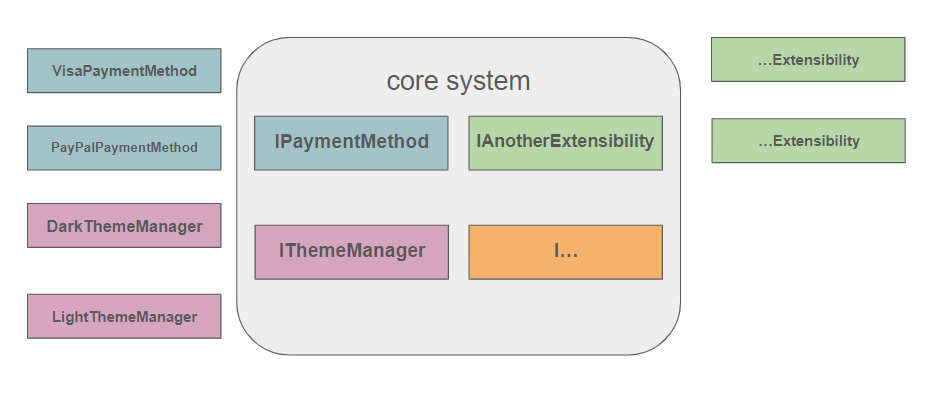Building a plugin architecture with Managed Extensibility Framework - Part 3
In this post, we will delve deeper than before by introducing the foundational aspects of plugin architecture.
What is a plugin architecture ?
A plugin architecture is a design pattern or framework that allows an application or system to be extended or enhanced with additional functionality through plugins or modules.

An application or system provides a core set of features and functionality (core system).
Plugins are separate pieces of code that can be added to the core system to extend its capabilities. Plugins are usually designed to perform specific tasks or add specific features (DarkThemeManager, LightThemeManager).
The core system is designed to dynamically load and integrate plugins at runtime, without requiring modification to the core codebase. This allows for easy installation, removal, and updating of plugins without disrupting the operation of the main application.
Plugins interact with the core system through well-defined interfaces or APIs (IPaymentMethod, IThemeManager). This ensures that plugins can integrate seamlessly with the core system and communicate effectively.
A plugin architecture provides users with the ability to customize the functionality of the application according to their specific needs or preferences. Users can choose which plugins to install based on the features they require, allowing for a highly flexible and customizable user experience.
Plugin architectures are commonly used in a wide range of software applications, including content management systems, web browsers, multimedia players, and integrated development environments (IDEs), among others. They provide a powerful mechanism for extending the functionality of software systems while maintaining flexibility, modularity, and ease of maintenance.
We can discern the presence of numerous extensibility points within the system. Contrary to our prior approach, which relied on implementing a Strategy design pattern, the current system exhibits greater openness. This means that third-party developers have the opportunity to create their own plugins. Furthermore, the software is intentionally crafted to facilitate this, a departure from the previous paradigm where only the manufacturer or proprietor possessed the ability to code extensibility points.
What are the various components comprising a plugin architecture ?
What is a plugin ?
A plugin is a modular component or extension that can be added to a software application to enhance its functionality or introduce new features. Plugins are designed to integrate seamlessly with the core system and are typically developed independently from the main application. They are often created to perform specific tasks or provide specialized capabilities, such as adding new tools to an editor, integrating with external services, or extending the functionality of a web browser.
Defining the host
The term "host" in our context refers to the core system of the software. Essentially, it represents the main program responsible for overseeing overarching concerns such as security and bootstrapping. Moreover, the host serves as the provider of the plugin API, which delineates the various extensibility points accessible within the system.
The host application bears the responsibility of loading and overseeing plugins, guaranteeing their proper execution, and furnishing them with requisite resources or data. This entails the dynamic loading of plugins into the system, managing their lifecycle, and orchestrating their interactions with the host environment. Furthermore, the host is tasked with ensuring that plugins operate seamlessly within the application's ecosystem, thereby contributing to the overall functionality and performance of the software.
Defining the interfaces
A plugin architecture necessitates the provision of interfaces to facilitate the seamless integration of plugins within the host system. These interfaces essentially serve as contracts, delineating the methods and properties that plugins must adhere to. Consequently, they establish a set of guidelines that plugins must follow to ensure proper incorporation into the host environment.
In essence, these interfaces act as a standardized framework that governs the interaction between plugins and the host system, fostering compatibility and coherence within the overall architecture.
Defining the plugins
Plugins, also referred to as modules or extensions, are discrete components that empower the expansion of a host application without necessitating recompilation. These self-contained units augment the functionality of the host system by introducing new features or capabilities, all while maintaining independence from the core codebase. This enables developers to seamlessly integrate additional functionality into the host environment, enhancing its versatility and adaptability without the need for extensive modifications or rebuilding of the entire application.
What constraints does a plugin architecture entail ?
As is often the case, every advancement in this world comes with its own set of trade-offs. While a plugin architecture facilitates the seamless integration of features into software, it also imposes certain constraints.
This section draws upon our specific experiences and may not necessarily apply universally or comprehensively to other scenarios.
While a plugin architecture can certainly serve internal purposes, its primary application lies in facilitating usage by third-party entities. Within this framework, security emerges as a paramount concern, necessitating continuous vigilance to thwart potential attempts by malicious actors to compromise the host system.
Addressing these security considerations is by no means a straightforward task; it often demands considerable time and effort to implement effectively.
Plugins frequently require access to internal data, such as orders for payment methods, and may need to interact with various types of information. Ensuring that plugins receive precisely the necessary data—neither more nor less—is more akin to an art than a science.
Given the complexities associated with modifying an interface post-release, it's imperative to anticipate and address this concern with careful foresight.
But enough with theory; let's delve into practical implementation! We'll now explore how a plugin architecture can be swiftly implemented in the .NET framework using the Managed Extensibility Framework (MEF).
Building a plugin architecture with Managed Extensibility Framework - Part 4